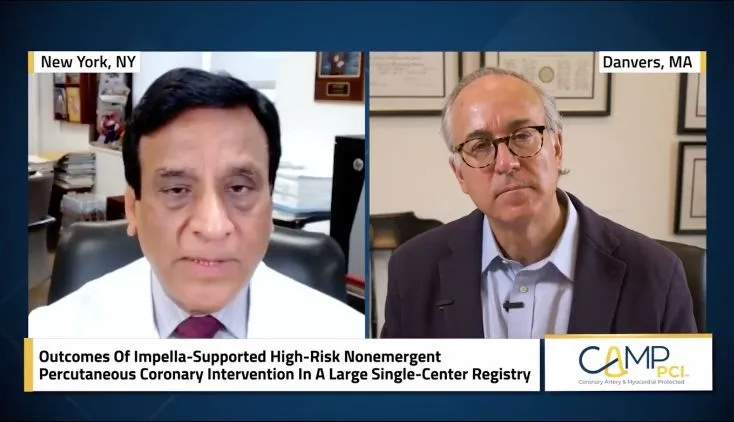Case Review, Protected PCI
Thomas Waggoner and Michael Cryer: Two Challenging Cases from Tucson Medical Center
Thomas Waggoner, DO, and Michael Cryer, M.D., present one live and one pre-recorded case from Tucson Medical Center in Arizona. Seth Bilazarian, M.D., and panelists Raj Tayal, M.D., and Katherine Kunkel, M.D., provide commentary.
The live case features a 78-year-old female patient with progressive dyspnea on exertion and multivessel coronary artery disease who previously had a four-vessel coronary artery bypass graft (CABG), but only one of the four vessels is still patent. She has a right coronary artery (RCA) chronic total occlusion (CTO) as well as calcified circumflex lesion and mid LAD lesion. The team’s strategy is to perform Impella-supported, intravascular ultrasound (IVUS)-guided PCI of the circumflex and then attempt antegrade wire escalation CTO intevention on the RCA.
The pre-recorded case, dubbed “the kitchen sink case,” features a very functional 85-year-old male patient who was turned down for surgery. The patient had refractory CCS II-III angina, severe aortic stenosis, and moderate-to-severe mitral regurgitation with an ejection fraction (EF) of 50-55% and STS risk 10.5%. His cormorbidities included atrial fibrillation, hypertension, hyperlipidemia, chronic kidney disease, heart failure with preserved EF, and coronary artery disease. Dr. Waggoner and Dr. Cryer performed what they called “percutaneous bypass” in this 4.5-hour case involving valvuloplasty and single access Impella CP support. They performed rotablation and stenting on the RCA as well as interventions on the LAD, circumflex, and left main. The team and panelists discuss duration of Impella support and benefits of right heart catheterization related to this case.
The live case features a very tortuous circumflex with a 90-degree bend that took a significant amount of time to wire, leading Dr. Tayal to comment, “Circs are like a box of chocolate, right? You never know what you’re going to get.” After gaining access, performing rotational atherectomy, and stenting, the team decides not to intervene in the RCA CTO and to bring the patient back for TAVR in a couple of weeks and then reassess the patient’s MR.
“It’s always prudent to be patient,” Dr. Waggoner states at the conclusion of the case. “In order to have purposeful progress, you have to maintain composure, you have to be always thinking ahead, the next steps, [and] having the correct tools in your toolbox makes things so much easier.”
Dr. Waggoner, Dr. Cryer, Dr. Tayal and Dr. Kunkel are compensated by and presenting on behalf of Abiomed and must present information in accordance with applicable regulatory requirements. This presentation includes Dr. Waggoner, Dr. Cryer, Dr. Tayal and Dr. Kunkel's opinions and findings based on their own knowledge and experience.
IMP-6457


